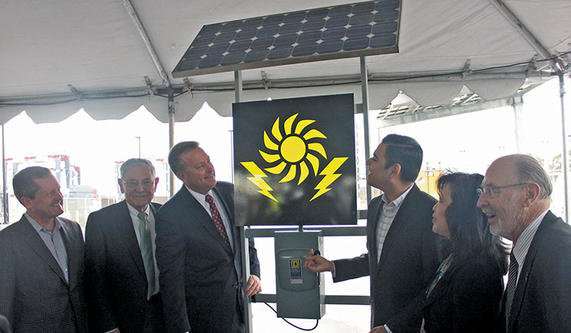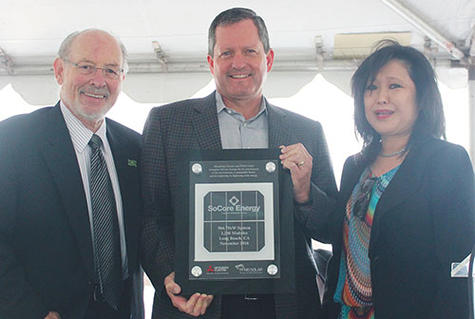Long Beach Container Terminal (LBCT) held a “solar celebration” to commemorate the completion of its solar panel installation project on what was, ironically, a gloomy November morning.
“Long Beach Container Terminal is taking a leadership role toward a more sustainable city,” Mayor Robert Garcia said at the ceremony. “I applaud the efforts of all parties involved in this installation, making LBCT a shining example of environmentally friendly port operations.”

Mayor Robert Garcia flipped the ceremonial switch at Long Beach Container Terminal (LBCT) to commission a solar panel project that will generate more than 1.5 million kilowatt hours of energy annually. Pictured from left: Allan Schurr, president of Edison Energy; Doug Drummond, a member of the Long Beach Harbor Commission; Anthony Otto, president of the LBCT; Mayor Garcia; and Gina Heng, vice president and general manager of Mitsubishi Electric; and James Hankla, senior vice president of government relations for PFMG Solar. (Photograph by the Business Journal’s Brandon Richardson)
The project, developed by PFMG Solar and installed by Rosendin Electric, consists of 3,290 solar panels made by Mitsubishi Electric on top of 12 carport structures at the Port of Long Beach’s Terminal E. The project will generate approximately 1,532,418 kilowatt hours (kWh) and avoid the creation of 1,127 tons of carbon dioxide annually. To give an idea of the magnitude of the power that will be generated, the average annual electricity consumption in 2015 for a single home was 10,812 kWh, according to the U.S. Energy Information Administration’s website.
James Hankla, senior vice president of government relations for PFMG, said there were many problems to overcome in order to see this project come to fruition. One issue was that solar projects within 500 feet of saltwater require special panels due to the corrosive nature of the salty ocean air.
“Solving those problems created the pathway to future port solar projects,” Hankla said. “Indeed, in solving these problems, we have forged new friendships, alliances and partnerships which will endure. The project we’re sitting in today has been a labor of love for PFMG and for me personally.”

Gina Heng, vice president and general manager of Mitsubishi Electric, and James Hankla (left), senior vice president of government relations for PFMG Solar, presented Allan Schurr, president of Edison Energy, parent company to SoCore Energy, a plaque to commemorate the commissioning of the solar panel project at Long Beach Container Terminal at the Port of Long Beach’s Terminal E. (Photograph by the Business Journal’s Brandon Richardson)
According to Anthony Otto, president of LBCT, the solar system at Terminal E has made it the first near-zero-emission container terminal in the world, which he hopes will be a model for ports around the globe.
Long Beach Container Terminal, a subsidiary of Orient Overseas Container Line, does not own the solar project, even though the equipment is on its property. Instead, the company hosts the project and entered into a 25-year power purchase agreement with SoCore Energy, a subsidiary of Edison Energy. SoCore paid for the development and installation of the project, and LBCT will purchase the electricity generated by the system.
“This is the kind of project that shows economic vitality, as well as environmental sustainability,” Allan Schurr, president of Edison Energy, said. “The port is such an important engine for the region, and things like this allow it to continue to grow and expand and contribute to the economy while they do their part for clean energy and other sustainability initiatives.”
Gina Heng, vice president and general manager of Mitsubishi Electric, was in attendance at the ceremony and spoke on behalf of the company. She congratulated LBCT and SoCore for their decision to install the system that will benefit not only their bottom line but also the environment and the community and its health for years to come.
“So many people had to sign off on this project, starting with the port, the city, the purchasers,” Paul Mikos, president of PFMG, said. “So it’s a fun day. It took longer than anyone wanted it to, but it’s another movement for the port turning green.”
